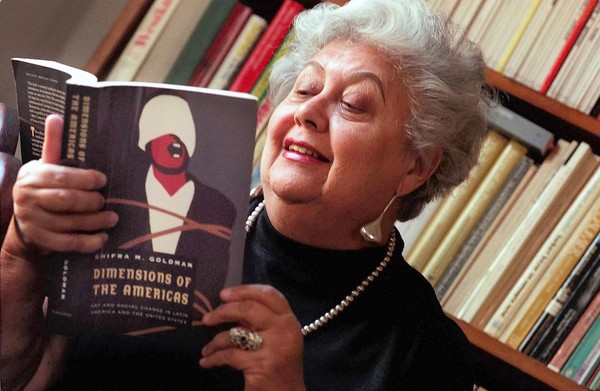Shifra Goldman dies at 85; champion of modern Mexican Art
By Elaine Woo, Los Angeles Times
Shifra Goldman was a civil rights and anti-Vietnam War activist who joined the Mexican American rights movement in Los Angeles and helped elevate Latin American and Chicano art history into legitimate fields of study.
In the early 1970s, when Shifra Goldman proposed a doctoral dissertation on modern Mexican art, her professors at UCLA sneered. Compared to European art, the art of Latin America was, in their view, imitative, too political, unworthy of serious scholarly attention.
But Goldman, a scrappy civil rights and anti-Vietnam War activist who went back to school in her mid-30s, refused to consider a more mainstream topic. Describing herself years later as a person who was “born on the margins, lived on the margins and … always sympathized with the margins,” she bided her time for several years until a more open-minded professor arrived who was willing to supervise her research.
She not only published her dissertation as a book, “Contemporary Mexican Painting in a Time of Change” (1981), but went on to become a seminal figure in the rise of Latin American and Chicano art history as legitimate fields of study.
Goldman died Sept. 11 in Los Angeles from Alzheimer’s disease, said her son, Eric Garcia. She was 85.
Calling herself an activist art historian, Goldman was an early champion of Mexican muralist David Alfaro Siqueiros and persisted for decades to preserve his last public work in the United States: the “América Tropical” mural at Olvera Street. The Getty Conservation Institute is collaborating with the city of Los Angeles to rescue the rare mural.
“There was no one like Shifra,” said artist and Cal State Northridge professor Yreina D. Cervantez. “She was an advocate and a scholar on Chicano and Chicana art long before it was recognized and … she put it in the context of the larger art world. Her commitment was unmovable and constant.”
Goldman “was an intellectual pioneer with strong social convictions,” said Chon Noriega, director of the UCLA Chicano Studies Research Center where Goldman was a research associate in the mid-1990s. Noriega described one of her books — “Arte Chicano,” a comprehensive 1985 bibliography co-written with Tomás Ybarra-Frausto — as “the bible for Chicano art history.”
“We really have to rewrite the history of modern art,” Goldman told The Times in 1992. “That’s the tall order that many of us have set for ourselves. You have to insert the modern art of Asia, Africa and Latin America.”
Born Shifra Meyerowitz on July 18, 1926, she grew up in New York steeped in the leftist politics of her parents, Jewish immigrants from Russia and Poland. She attended the city’s High School of Music and Art before moving to Los Angeles in the 1940s.
A studio art major at UCLA, she joined a student boycott of Westwood barbers who refused haircuts to African American veterans of World War II attending UCLA on the GI Bill. She left UCLA before earning her degree and immersed herself in the nascent Mexican American civil rights movement led by activist Bert Corona. She learned Spanish living in East Los Angeles and in 1952 married John Garcia.
The marriage ended after a few years, and a second marriage also ended in divorce. She is survived by her son and a grandson.
“She said she was a women’s libber before it existed,” her son, Eric, said last week. “She had a hard time with men. They didn’t want this intellectual powerhouse. She was a very intense woman.”
During the 1950s Goldman worked in a factory assembling refrigerators and stoves; later she was a bookkeeper. She remained active in radical causes, which in 1959 led to a subpoena to appear before a panel of the House Un-American Activities Committee. She refused to answer questions.
Unsatisfied with her life, she returned to UCLA, completing her bachelor’s degree in art in 1963. She earned a master’s from Cal State L.A in 1966 and a doctorate from UCLA in 1977, both in art history.
She taught at a number of colleges in Southern California, including Santa Ana College, until 1992, when she retired from full-time teaching.
In 2008 she donated her meticulously organized collections of correspondence, articles, books, museum catalogs, gallery announcements and art slides — many showing works that have disappeared — to the California Ethnic and Multicultural Archives at UC Santa Barbara.
“Anybody who was seriously involved in Latino/Chicano art has visited Shifra at home and gone through her collection. She was the archivist of the field,” Noriega said.
Her archive includes material about Siqueiros’ “América Tropical,” which was badly deteriorated after decades of neglect when Goldman discovered it in 1968. Olvera Street merchants had painted over the mural soon after its completion in 1932 because of its controversial depiction of a Mexican Indian crucified on a double cross under an American eagle. An Aztec and a Mexican revolutionary are pointing rifles at the eagle.
“It was Shifra who really spearheaded the very first effort to preserve the Siqueiros mural,” said filmmaker Jesus Treviño, who worked with her to make a 1971 KCET documentary about it. “There were artists who said to her, ‘Let me repaint it,’ but she said, ‘If the Mona Lisa fades you don’t have someone come in to repaint it for Da Vinci.’ She was adamant that this was by a great artist and the original work should be preserved.”
The Getty and the city expect to unveil the mural and a new interpretive center next year.
“It is the last Siqueiros mural to remain in its original site in the U.S.,” said Leslie Rainer, the Getty mural specialist who is overseeing the conservation project. “Shifra understood its importance.”
A memorial will be held at 2 p.m. on Oct. 15 at the Professional Musicians Local 47, 817 Vine St., Hollywood, CA 90038.
